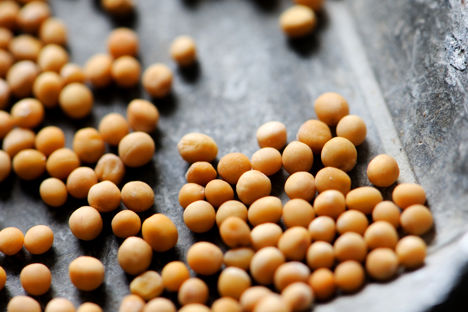The versatile mustard plant belongs to the same family as broccoli, sprouts, kale and cauliflower. All parts of the plant are edible, and while pickled mustard greens are widely found in East Asian cuisine, and the husks of the seeds are pressed to produce mustard oil, it’s the seeds which are most commonly used in cooking.
Many South Indian recipes begin with the popping of mustard seeds in hot oil to provide a nutty flavour, but it’s the chemical reaction that happens while crushing the seeds and mixing with liquid that produces that nose-burning hot flavour most of us know as mustard.
Making your own mustard is easier than you might think – it’s as simple as crushing the seeds with a liquid and adding a preserving agent such as vinegar, sugar or salt – but there are many variables to create different strengths and flavours.
First the seeds; you have white (or yellow), brown and black to choose from. The white seeds are slightly milder, brown are punchier and black are the most potent. You can grind them right down to achieve a smooth mustard, or just crush them lightly for a textured wholegrain mustard, depending on the desired consistency.
Many different liquids can be used, including water, vinegar and lemon juice; or alcohols such as beer or wine. The famous Dijon mustard originally used verjus (a type of unripe grape juice) which rose to prominence thanks to its tart flavour that gave a smooth, less acidic finish.
The heat of the mustard depends on the temperature of the liquid used when blending. English mustard (the hottest type) is made with cold water, whereas American ‘yellow’ mustard is brought to the boil, which gives it a milder flavour, with plenty of turmeric added for that vivid colour.
The choice of liquid also determines how long the potency of the mustard will last. Cold water will give a punchy mustard for a day, but soon deteriorates over a couple of days, while vinegar ages nicely and preserves the strength of the seeds. Mustard can be stored out of the fridge indefinitely without going bad, but the potency can weaken. If your old mustard is tasting a little bland, mix with a little vinegar which will liven it up again.
Some mustard recipes include a sweetener of some kind, usually sugar or honey. Bavarian mustard contains dark brown sugar to give it that almost treacle-like sweetness, and works well slathered over a bratwurst with some tangy sauerkraut.
The recipe below is a great start to making your own mustard – once you've mastered this, feel free to experiment with a range of flavours and textures.
Metric
Imperial
- 100g of mustard seeds
- 300ml of white wine, vinegar or beer
- salt
- sugar, or honey
After you have mastered this simple base, it's time to add flavourings. Taste the mustard and season with salt and sugar or honey; you can add turmeric to enhance the colour, or other spices such as black pepper or ground cloves for something aromatic. The addition of fresh herbs makes for a beautiful mustard – finely chopped tarragon is a classic example.
Further variations
The sky really is the limit with mustard, so keep tasting and adapting. Cassis mustard, for example, makes a beautiful pairing with game. Some finely chopped walnuts or hazelnuts would make an excellent mustard for a cheeseboard, or you can even add some rich stock to for a meaty finish.
It is important to give your mustard a day – or in some cases a week – to develop in flavour and lose any initial bitterness.
What mustard goes with...
Mustard is a very versatile condiment. Traditionally enjoyed with cold cuts of Yorkshire ham, roast beef or terrines, it also lifts heavy cream dishes like macaroni cheese. Marcello Tully’s Poussin with mustard sauce and mushrooms or Nigel Mendham’s Mustard panna cotta with heritage beetroot and goat’s cheese crumble demonstrate the versatility of this condiment.
Due to its ability to emulsify, mustard is commonly used as an ingredient in other condiments such as mayonnaise and the wonderful French classic ravigote sauce. It’s also the secret ingredient in many classics like Welsh rarebit, croque madame and barbecue sauce.
Get in touch
Please sign in or register to send a comment to Great British Chefs.



